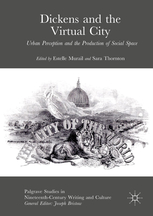
Dickens and the Virtual City : Urban Perception and the Production of Social Space
Publication | Table des matières | Critiques
Résumé
This book explores the aesthetic practices used by Dickens to make the space which we have come to know as the Dickensian City.
It concentrates on three very precise techniques for the production of social space (counter-mapping, overlaying and troping).
The chapters show the scapes and writings which influenced him and the way he transformed them, packaged them and passed them on for future use.
The city is shown to be an imagined or virtual world but with a serious aim for a serious game: Dickens sets up a workshop for the simulation of real societies and cities.
This urban building with is transferable to other literatures and medial forms.
The book offers vital understanding of how writing and image work in particular ways to recreate and re-enchant society and the built environment. It will be of interest to scholars of literature, media, film, urban studies, politics and economics.
Estelle Murail is Research Fellow in the LARCA research centre at the University of Paris Diderot, France. She also teaches at the at the Lycée Saint-Jean de Passy in Paris. She gained her jointly-supervised PhD in English Literature at the Université Paris Diderot and King’s College London. Her PhD examined the figure of the flâneur in London and Paris in the Nineteenth Century. She has published several articles on flânerie, London and Paris in literature. She has taught English Literature and translation at the Université Paris-Diderot, at the Université Paris Est Marne-La-Vallée and at Sciences-Po Paris.
Sara Thornton is Professor of English at the University of Paris Diderot, France, where she teaches nineteenth-century literature and cultural studies. She is president of the SFEVE (Société Française d’Etudes Victoriennes et Edouardiennes). She has published Advertising, Subjectivity and the Nineteenth-Century Novel (Palgrave Macmillan, 2009), David Copperfield (2006), Circulation and Transfer of Key Scenes in Nineteenth-Century Literature (2010), Persistent Dickens (with Alain Jumeau, 2012), and Littérature et publicité (co-edited with L. Guellec and F. Hache-Bissette, 2012). She is currently working on the way aesthetics responds to economic pressures in the nineteenth-century in Britain and the Empire.
Table des matières
- Dickensian Counter-Mapping, Overlaying, and Troping: Producing the Virtual City
Pages 3-32
Murail, Estelle (et al.) - The Railway and the River: Conduits of Dickens’ Imaginary City
Pages 35-56
Moore, Ben - Re-envisioning Dickens’ City: London Through the Eyes of the Flâneur and Asmodeus
Pages 57-77
Murail, Estelle - The Bleeding Heart of Criminal Geography in Dickens’ London
Pages 79-98
Bertrand, Cécile - One Hundred and Five, North Tower’: The City as a Prison-Home Narrative in Charles Dickens’ A Tale of Two Cities (1859)
Pages 99-118
Athmanathan, Divya - The ‘Something’ that His Brain Required: America’s Role in the Development of Dickens’ Urban Imagination
Pages 121-132
Aycock Metz, Nancy - Dickens and His Urban Museum: The City as Ethnological Spectacle
Pages 133-153
Robles, Fanny - ‘Reddening the Snowy Streets:’ Manchester London, Paris or a Tale of Three Cities
Pages 155-174
Lanone, Catherine - ‘Our Mutual City:’ The Posterity of the Dickensian Urbanscape
Pages 175-194
Letissier, Georges - The Role of Hypallage in Dickens’ Poetics of the City: The Unheimlich Voices of Martin Chuzzlewit
Pages 197-215
Dupeyron-Lafay, Françoise - No Thoroughfares in Dickens: Impediment, Persistence, and the City
Pages 217-239
Tambling, Jeremy - A Production of Two Cities and of Four Illustrators
Pages 241-271
Allingham, Philip V., Ph.D.
Critiques
- “It is a topic that has appealed to scholars and anyone fascinated by Britain’s world city, but also by the representation of urban experience as a phenomenon of modernity, as well as postmodernity.”
Efraim Sicher, Dickens Quarterly, Vol. 37 (1), March, 2020 - “This important volume from an authoritative international team of authors sheds significant new light on the comparative development of post-war Conservatism in the western world.”
– Stuart Ball, Professor Emeritus, University of Leicester, UK - “The rich essays collected in this illuminating volume show that the rise of right-wing politics in the United Kingdom, the United States, and France since the 1970s was a remarkably transnational phenomenon. As they attacked social democracy and cultural pluralism, right-wing movements borrowed ideas, visions, vocabularies, and tactics from each other, adapting them to their own national idioms and using advances in one country to win advances elsewhere. Anyone interested in confronting the problems that have proliferated in the wake the right’s reconfiguration of politics – surging inequality, belligerent ethno-nationalism, worker disempowerment and insecurity, and lost faith in the capacity for democratic self-government – has much to learn about the origins of these problems from this important book.”
– Joseph A. McCartin, Georgetown University, USA, author of Collision Course
